The UK’s first completely Cashier-less grocery store
The British supermarket Sainsbury’s has recently announced the end of its cashier-less store trial, concluding that ‘it’s clear that not all our customers are ready for a totally till-free store.’
The initiative involved the UK’s first till-free grocery store, utilising a mobile app with smartshop scan, a pay & go technology where customers can scan items with their mobile’s cameras as they move through the store.
Whilst there is huge potential in this technology which Sainsbury’s are trailblazing for, the trial did certainly have some initial setbacks. The pilot store experienced long lines at the help kiosk, due to many customers wanting to pay with cards and cash.
In response to this, Sainsbury’s have added a manned till and two traditional self-checkout tills to support the store’s mobile payments. Whilst this does mean the concept of a completely cashier-less store has been shelved for now, the mobile-scan option was clearly a sucess, with Sainsbury’s adding the payment option to eight additional stores.
Convenience isn’t one-size-fits-all
The first thing this technology-project highlights is the necessity of piloting new solutions before rolling them out on a larger scale. Sainsbury’s not only got this right, but they clearly paid attention to their customers during their pilot.
Whilst it’s possible Sainsbury’s were partly-motivated about the possibility of totally cashier-less stores (and the operational benefits those would bring), they rightly put their customers first and acknowledged an important truth: Convenience isn’t one-size-fits-all.
Improving customer experience is typically one of the main targets for technology investments in the retail industry. But doing this effectively is often about giving the customer more options, rather than just replacing the existing ones with something more modern and innovative.
Ultimately, solutions like this are designed to make shopping faster (One half of a strong customer experience). However, if you take options away from customers, especially ones they will naturally expect to have, you can slow the experience down and inadvertently add a friction point to your store.
Key Takeaways:
- When releasing new technologies, piloting the solution first in a small number of stores is crucial.
- When evaluating the success of pilots, it’s important to be unbiased and measure the full range of impact of the technology – This includes qualitative results as well as the regular measurable statistics.
- When improving customer experience, technology should look to give customers more options rather than replace existing ones that they may have grown to expect.
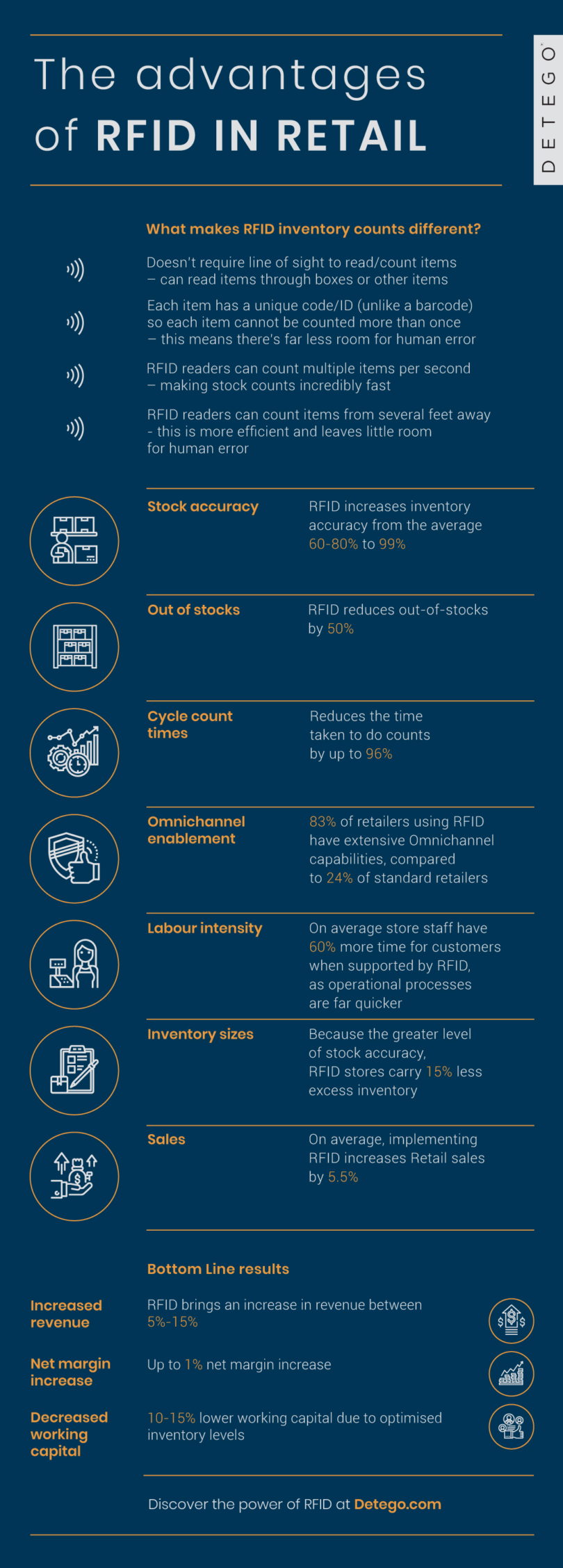
The 6 Key Benefits of RFID in Retail
RFID (Radio Frequency Identification) uses radio waves to track and identify tags attached to objects. The tags contain electronically stored information and are counted or ‘read’ by either handheld or fixed RFID readers.
In many ways RFID is used in retail as an alternative to a barcode system (although it doesn’t have to replace barcodes entirely). The more advanced technology involved in RFID mean it has a far greater level of accuracy and efficiency when it comes to counting inventory. As a result of this it has far broader applications in retail, most of which are built of off the back of this reliable inventory visibility.
By implementing RFID retailers can on average increase their revenue from 5-15% depending on the business. This on top of a margin increase of up to 1% and 10-15% lower working capital due to optimised inventory levels.
According to research in 2018, 69% of retailers cite a significant level of adoption, and this number is continuing to rise.
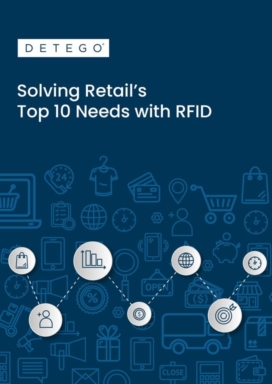
eBook
Solving Retail's Top 10 Needs with RFID
Discover how retail RFID is changing the industry for good. This eBook will guide you through the top 10 needs identified by retailers to ensure sustainable success in the modern environment. Explore the common challenges preventing retailers from achieving their goals and learn how applying smart RFID-based solutions delivers consistently good results.
Inventory Visibility

Due to the ease and accuracy of RFID stock counts, retailers using the technology can reliably achieve full item-level inventory visibility across their stores and supply chains. Crucially, due to the speed of RFID inventory counts, this can be achieved whilst actively reducing the labour intensity of operational processes. This accurate and up-to-the-minute inventory information is the backbone of so many of RFID’s uses in retail (including many of the points discussed below).
One crucial aspect of modern retail that relies on having accurate inventory visibility is Omnichannel retailing. With a complete and up-to-date view of stock across all channels, it is possible to open up the inventory of your entire store network to customers, providing a better customer experience and increasing sales.
Benefits of item-level inventory visibility
- Improved shipping accuracy
- Excellent baseline for advanced omnichannel retailing
- Produces more data for better insights
- Reduces inventory size (and therefore working capital) significantly
- Increased customer satisfaction from reduced out-of-stocks and a more connected experience
Increasing Product Availability

Ensuring a high product availability is vital to maintaining retail sales. Despite this, low on-floor product availability and out-of-stocks are an alarmingly common problem in the industry, causing unnecessary lost sales as a result of inefficient replenishment processes and stock inaccuracy. This latter cause is practically removed completely by RFID, with typical stock accuracy being increased to 99% from the standard 60-80%.
Additionally, RFID platforms provide an unbeatable basis for efficient and reliable replenishment processes. The main advantage these platforms have is the item-level and real-time inventory visibility gained from regular 99% accuracy stock counts.
How does RFID increase product availability?
- Makes regular cycle counts possible with efficient RFID stock reads
- Removes stock inaccuracy (from 70-80% to 99%)
- Creates complete item-level view of stock between both backroom and sales floor
- Item visibility makes replenishment easier and more accurate
- Real-time view allows for replenishment alerts for when items/sizes are running low
- Item-level data from RFID allows for advanced, even AI-assisted planograms for individual stores
Supply Chain Traceability

We’ve discussed the difference item-level visibility makes for stores, but when it comes to supply chains the benefits are just as great. With RFID, inbound and outbound reads become far easier, and are done on an individual item level rather than SKU (stock keeping unit). This means each item is accounted for at each step of the supply chain, rather than just shipments or boxes.
This level of stock visibility also drastically reduces the rate of shipping errors or picking mistakes as they are detected by RFID readers and corrected by warehouse staff during exception handling or outbound reads.
Additionally, the location or status of items and shipments are visible in real-time, so stores and DC’s can easily track shipments and know exactly what they will be receiving. This makes any individual item fully traceable, as time and dates of when the item passed each read point in the supply process can be stored.
Benefits of RFID in the supply chain:
- Item-level visibility across entire supply chain
- Trace items against individual shipments
- Smoother operational processes
- Track shipments for delivery
- 100% inbound and outbound shipping accuracy
Increasing Process Efficiency

The difference in process efficiency from using RFID in retail is extensive, at every end of retail, be it the factory or the shop floor. An RFID reader, regardless of whether its fixed or a handheld, can read hundreds of individual items at once. Crucially though, as each item has a unique ID, they can never be read more than once. The signals also do not require line of sight to be read.
Naturally, this makes RFID inventory counts and inbound/outbound checks incredibly fast and reliable. In the case of store inventories, RFID has been found to reduce cycle count times by a staggering 96%. This therefore means they are far more convenient to perform and can be done multiple times in a week rather than a year.
Processes transformed by RFID:
- Cycle counts/inventories
- Fast & Efficient Inbound & Outbound reads
- RFID-enabled picking and packing
- Mobile guided replenishment from backroom to salesfloor
Providing Real-Time Data

Analytics and data is one area that e-commerce is ahead of physical retail. This is largely due to the fact that everything online can be measured, whereas retailers don’t really know what’s happening with their stores and customers in any specific detail, and the stats and data they do collect are often historical and at risk of being outdated.
However, with RFID this can all change. The simplest and most effective use of the data allows retailers to better leverage their greatest assets; their products and their stores. Quality data and analytics can allow retailers to ensure merchandise is in the right place to be sold. Information on which stores are performing better or worse is a basic retail KPI, but with specific item data, RFID produces far more detailed insights. This includes how well individual items are doing in specific stores, right down to specifics such as which sizes of items are selling better where. Insights such as these are naturally actionable, meaning retailers can take steps to move or reinforce stock at specific stores.
Data insights and results possible with RFID:
- KPI based performance tracking
- Detailed merchandise data & Analytics
- Operational excellence
- Actionable recommendations
- Compliance tracking
- Eliminates reliance on historical data
- Predictive capabilities for inventory counts and merchandise management
Transforming Customer Experience

There are many effects of RFID in retail that go beyond simple operational benefits to actively improve the customer experience. At the most basic level, this includes things already mentioned like increasing product availability, offering convenient omnichannel services and freeing up store associates to spend more time assisting customers.
However, because of the real-time inventory visibility it provides, RFID can go way beyond this in terms of improving the customer experience. For example, with reliable and up-to-the-minute stock information stores can utilise technologies like chatbots or smart fitting rooms to assist customers with their queries, supply information about other items or sizes available and even cross-sell to customers in the store.
What ways does RFID improve the customer experience?
- High product availability
- Store associates have more time for their customers
- Convenient omnichannel services
- A connected experience between online and offline
- AI-powered chatbots delivering assistance and product information via mobile.
- Smart fitting rooms providing a hugely improved fitting room experience.
- RFID-enabled Point of Sale – including self-checkout services

eBook
Solving Retail's Top 10 Needs with RFID
Discover how retail RFID is changing the industry for good. This eBook will guide you through the top 10 needs identified by retailers to ensure sustainable success in the modern environment. Explore the common challenges preventing retailers from achieving their goals and learn how applying smart RFID-based solutions delivers consistently good results.
The age of digital disruption has caused a shift in both consumer expectations and the retail landscape as a whole. Naturally, many retailers have looked towards implementing new technologies in an attempt to either adapt to or capitalise on these changes. When researching new retail technologies, the focus should be on transforming the customer’s experience and eliminating existing friction points.
The question needs to be asked, is this directly solving a major problem for retail customers? In other words: Is there a demand for it? Focusing on the comparatively mundane details first needs to be a priority, as attention on what drives customer experience at the most basic level can be the difference between success and failure in the age of digital disruption.
One technology that consistently meets these demands is radio Frequency identification. RFID is a growing force in retail, with 69% of retailers around the world citing a significant level of RFID adoption. The technology involves tagging individual items of merchandise, like a barcode but entirely unique to the individual item that can be ‘read’ and tracked with ease. One of the most common business cases for the technology is the process accuracy and efficiency that it delivers, but the difference that RFID can make to the customer is not to be overlooked.
Out-of-stock situations
Empty shelves are a simple problem, and yet are still a painfully common occurrence in retail. In a survey by Elastic Path, it was found that 55% of shoppers surveyed had experienced an issue with out of stock inventory. Is it then any wonder then that ecommerce is putting pressure on brick-and-mortar stores?
As obvious as it might sound, a product can only be bought if it’s on the shop-floor. If replenishment isn’t automated or falls victim to human error, stores can be temporarily faced with unnecessary out of stock situations that damage both sales and reputation. This problem is often a subtle one, with stores and retailers having no way of observing the true level of item availability.
With a cloud-based RFID platform that utilises the Internet of Things, on-floor availability becomes much easier to manage, significantly reducing out-of-stock situations by up to 50%. The main way this is achieved is through fast and accurate stocktakes and automated replenishment processes. Store staff can now perform stock takes of an entire store (50,000 items) in just 25 minutes to a level of 99% accuracy.
This full and accurate view of store stock combats out-of-stocks in two ways. Firstly, the visibility of stock provides store staff to easily monitor stock levels. More advanced RFID systems like the Detego platform can not only operate in real-time and provide replenishment alerts, but can they can also use machine learning to suggest optimised replenishment advice, set on either a set planogram or an AI-optimised one.
Disconnect between online & offline
The increasing influence of online and ecommerce is arguably the biggest driver of digital disruption in retail. The convenience and choice that shopping online offers has resulted in highly demanding modern customers. Whilst these days practically every brick-and-mortar retailer has expanded into e-commerce to meet these consumer demands, there is unfortunately a noticeable disconnect between many retailer’s online and offline shopping channels, damaging the customer experience despite best intentions.
The key to a good ‘omnichannel’ shopping experience is not to necessarily be everywhere, but to be seamless and flexible at every step of the shopping journey. Non pure-play retailers that can do this will have a competitive advantage, not least because of the choice they offer customers, but with features like click-and-collect and ship-from-store, they can offer an unmatchable level of flexibility whilst opening up the entire inventory network to all channels.
To be able to do this, retailers need a complete and real-time view of stock across their store network in all channels. RFID provides this through digitising stock (utilising the IoT) and tracing the movement of individual items in real-time. With this foundation, it is possible to build extensive and reliable omnichannel services, blending shopping channels and providing a flexible and convenient experience for customers. RFID is the backbone of strong omnichannel services such as this. In fact, 83% of RFID adopters offer three or more omnichannel fulfilment options compared to only 24% of non-adopters.
At its most basic level, this can include opening up stock transparency to customers so they can check availability of items online before coming into a store. The more advanced features include click-and-collect and ship-from-store, both of which provide a competitive edge against pure-play ecommerce, as customers get a more convenient and flexible shopping experience regardless of which ‘channels’ they use.
Limited Customer service
When discussing disruption and new technologies, its easy to forget about core principles and traditional strengths, but technology should be built with those in mind. For retail stores, that means customer service. This remains a key part of physical stores’ USP today, but with the demand for store associates’ time being severe, these traditional strengths can sometimes be left behind.
In studies by Elastic path it was found that 42% of shoppers surveyed said they’d had an issue with long wait times for customer service, suggesting that something new is required to stop what was once a core strength of stores becoming a friction point for customers.
RFID platforms meet this demand in two different ways. First and foremost, is simply the fact that RFID operations are much leaner and less labour intensive, for example it cuts cycle count times by up to 96%. This has the simple yet effective result of drastically decreasing the amount of time retail staff have to spend on manual processes like replenishment, therefore freeing up a significant amount of staff time to be spent elsewhere with customers.
The other significant ways RFID can assist customer service are the platforms and features that can be built around the technology. Mobile chatbots can assist customers with queries about item availability and available sizes, thanks to the real-time item transparency produced by RFID. In the fashion industry, Smart-Mirrors can do this whilst also reducing the friction points associated with changing rooms, as they can provide information from within the fitting room and can also be fitted with features to call store assistants to bring any items required to the fitting room.
In recent years the digital age has shaken up retail in unprecedented fashion, and this trend looks sure to continue. One of the main causes of this change is the internet, not only the increasing influence of e-commerce but also the changing standards consumers are used to thanks to their near-constant access to the web. The new status quo of the digital world is connection and convenience, as modern customers have easy access to information and services on demand.
But is retail keeping up with this change? And what does it take for brick-and-mortar stores to meet these modern demands? Thankfully, the growth of retail technology means stores have more tools than ever to do so. Retailers need to look towards digital investment to reduce friction points and offer a more streamlined and connected shopping experience.
In other words, brick-and-mortar stores aren’t going anywhere, but they will have to evolve.
Enter the digital store
With customers being more connected than ever and used to the experience they can have shopping online, it’s time for brick-and-mortar stores to take some lessons and adapt. This shift is well underway, and as more brands continue to adapt one thing is becoming clear, digital doesn’t just mean online anymore.
Thanks to the Internet of Things, it’s now possible to digitise every single item in a store, in conjunction with tracking technology such as RFID. This allows retailers to leverage their most important asset, their merchandise, with greater precision.
For example, let’s present an all-too-familiar scenario.
You are looking to buy a new pair of shoes. You’ve decided to purchase them in-store because you want them today and need to make sure the fit is right. Before going to the store, you checked on the store’s website to check if they had them in stock in your size, but it didn’t say. After failing to find them in the store, you ask a store associate who offers to look in the back. You then wait several minutes, for them to return empty-handed, and offer their apologies.
There are several stages where this scenario could have been avoided with the application of the IoT. If every item is digitised and traced effectively, not only can stores know exactly what’s in stock, but retailers can share this information with their customers, and offer them more options like click and reserve and more.
Stores as Digital hubs
With this baseline of technology providing a clear view of inventory across store networks, the natural next step is combining and unifying digital stores with the rest of the digital network, namely other stores and the e-commerce online store. After all, online is already digitised by nature, and having all stock across all networks digitised allows retailers to leverage their products far better to serve their customer’s needs.
Whilst omnichannel has become a bit of a buzzword, with the focus on connection and convenience for customers, features like click-and-collect and ship-from-store are essential for leveraging physical stores. When supported with appropriate technology like RFID, retailers can offer extensive omnichannel services thanks to a real-time view of stock and the ability to track and trace items across the supply chain.
Features like this go beyond levelling the playing field with e-commerce as they do something pure-play online retailers can’t, offering their customers more options and a flexible shopping experience.
If you are interesting in further exploring how digitisation improves the customer experience, download our free whitepaper on how fashion stores leverage The Internet of Things (IoT) technologies to put the customer in focus of all activities.
If you are interesting in further exploring how digitisation improves the customer experience, download our free whitepaper on how fashion stores leverage The Internet of Things (IoT) technologies to put the customer in focus of all activities.
Did we spark your interest?
Digital stores are the stores of the future. This is because these days, with both fierce competition from e-commerce and customers with more options and expectations than ever before, nothing should be left to chance. Because a positive visit to a store becomes an experience that leaves a long-lasting impression.
Whilst store design and a customer-centric experience remain crucial, brands need to invest in technology to ensure stores can meet modern consumer’s expectations.
As more and more brands are competing for the shopping budget of fewer and fewer customers, the intention is to create customer loyalty towards the brand. To this end, the digitisation of stores creates a more seamless shopping experience and bridges the gap between online and offline shopping.
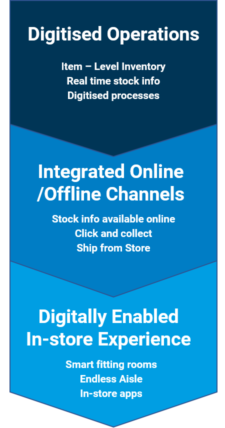
What is a Digital Store?
Maybe you’re thinking of high-tech stores loaded with interactive touchscreens, and while those stores do exist, the truth is more that stores are becoming increasingly digitalised on a back-end and operational level. This is a trend we see in business in general, improving efficiency by digesting processes or using intelligent software.
So, what does this look like for brick-and-mortar stores? A digital transformation of a store is largely centred around a stores core offering – it’s products. Technology is being used to digitise the way products are processed, with RFID stocktakes, and managed, with digital applications.
Stores not only digitise time-consuming manual processes such as stocktakes and replenishment, but they also digitise the view of stock itself. This means stores have reliable visibility on all store inventory, on an item-level. This allows for omnichannel services like click-and-collect and ensures the store experience is optimised to a point that it consistently delivers – no operational mistakes and no more disappointing customers with unavailable products.
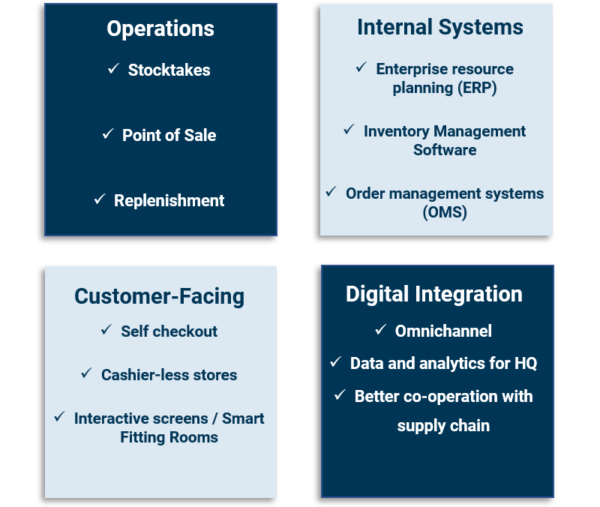
What are the advantages of Digitising Stores?
The Digital transformation of stores delivers benefits all across the value chain.
For store staff on an operational level, they spend less time performing manual administrative tasks like inbound order processing or stock management – reducing labour costs and freeing up staff to attend to customers.
The store itself benefits from an accurate inventory meaning quicker reordering, fewer out-of-stocks, and ultimately higher sales.
If we zoom out a level to look at a network of multiple digitised stores the retailer can use this real-time view of stock to make better decisions run a smoother supply chain and build a first-class omnichannel offering.
The customer enjoys a friction-less experience with fewer out-of-stocks, staff who know exactly what is available both in their store and online, and convenient purchasing options like click-and-collect.
Benefits for the store
- Real-time control over inventory and more efficient replenishment
- Greater inventory accuracy
- Quicker reordering
- Reduction in reserve stock
- Increase in staff efficiency
- Increased sales
Benefits for the customer
- Reduces out-of-stocks, reduces disappointment
- Able to get accurate information on stock levels both online and in-store
- Convenient omnichannel features like click-and-collect
- Staff have more time and more information to assist customers with
The 10 Steps to Building the Digital Store
Here’s what you have to do as a retailer to strategically set up your stores for digitalisation:
1) Lay the foundation for real-time article accuracy with RFID-based labelling
2) Accelerate the process of goods-inbound: delivery notifications, preparation on the sales floor, check-in of merchandise even if the boxes are still unopened, bring merchandise faster to the sales floor
3) Make use of effortless permanent inventory monitoring for a complete item transparency
4) Transform your sales personnel into more competent shopping consultants equipped with tablets and unburden them from administrative tasks
5) Set the stage for your brand through pure and spacious merchandise presentation with only a few items on the sales floor
6) Automate and speed up the replenishment process
7) Set up an early notification system to prevent out-of-stock situations
8) Retain the customers in the store by ensuring that they have access to real-time availability information
9) Ensure that you have an efficient click & collect system in place
10) Optimise the flow of merchandise from the central warehouse as well as between individual stores
The Detego Platform: A quick start to the digital store
The Detego Platform brings all of this together in an out-of-the-box solution, providing an easy and cost-effective fast track to the digital store. It does so by utilising item-level RFID tagging combined with the Internet of Things (IoT), digitising store inventory via a mobile application.
By doing this the store knows exactly what merchandise they have, and more specifically what is in the backroom and on the sales floor. This increases inventory accuracy, on-floor availability and dramatically improves store efficiency. Additionally, as the Detego platform is built to fully integrate with existing tech like ERP systems, this real-time stock visibility can easily be made available to the customer including online stock enquiries, click and collect and click and reserve.

Cloud-hosted RFID software
Stock Accuracy, On-Floor Availability, and Omnichannel Applications in Stores.
Detego Store is a cloud-hosted RFID solution which digitises stock management processes, making them more efficient and more accurate. Implemented within hours, our multi-user app can provide intelligent stock takes and a smart in-store replenishment process. Later, you can scale the solution to offer omnichannel services and effectively manage your entire store operations with real-time, item-level inventory visibility and analytics.
The retail environment has never been more demanding than it is today, thanks to fierce competition, the growth of e-commerce, and consumers’ high expectations for seamless shopping experiences. It’s a situation made even more difficult by a lack of inventory visibility, the complexity of supply chains and the sheer variety of products retailers are faced with. With conventional inventory systems typically operating at between 60 to 70 per cent stock accuracy and on-floor product availability, it’s no wonder brick-and-mortar sales are declining due to out-of-stock situations and poor customer experiences.
While retailers are faced with a growing number of solutions to these issues, RFID is the only technology that’s proven to consistently meet retailers’ needs for leaner processes, accurate inventory visibility and real-time data analytics.
“When RFID is implemented correctly, retailers are achieving up to 99 per cent inventory accuracy and product availability, reducing out-of-stock situations by 50 per cent and seeing a revenue increase of between 5 to 15 per cent”
When RFID is implemented correctly, retailers are achieving up to 99 per cent inventory accuracy and product availability, reducing out-of-stock situations by 50 per cent and seeing a revenue increase of between 5 to 15 per cent. A recent study by Accenture showed 69 per cent of retailers worldwide cite a significant level of RFID adoption, making RFID the clear leader in digitising retail supply chains and stores. However, how retailers go about implementing this technology is crucial to future success and longevity.
As with any technology project, choosing the right partner is vital. This is particularly true of RFID projects, where complex supply chains and rapid turnover of goods need to be managed on a global scale. By selecting specialised and experienced professionals who understand a retailer’s business model and its challenges, retailers can build an infrastructure of people who will ensure a successful implementation.
Detego, which has been implementing its RFID-based software platform for over 10 years, believes that a comprehensive solution is another key to success. When built with purpose, flexibility and user experience in mind, retailers can maximise the benefits provided by RFID technology. Detego’s modular platform covers everything from the factory to distribution centres, stores and even consumer engagement in the store. In this way, Detego can help retailers quickly and systematically unlock the power of RFID technology to seamlessly merge online and offline retail.
“By selecting specialised and experienced professionals who understand a retailer’s business model and its challenges, retailers can build an infrastructure of people who will ensure a successful implementation.”
Due to the resource requirements and financial implications of an RFID project, a proven implementation strategy is crucial to manage process change and boost ROI. Detego does this through a three-phase approach which starts with piloting its software in a handful of selected stores to prove the business case. Typically, the next stage is a rollout of the store network where the revenue uplift from increased inventory accuracy and product availability can fund the ongoing investment in RFID. Next, Detego will continue to move upstream to the distribution centres, allowing for complete supply chain visibility and the introduction of its omnichannel features. This enables retailers to access all routes to market as well as introducing consumer engagement solutions such as smart fitting rooms and/or chatbots.
Detego’s proven experience and methodologies are continuing to pioneer the future of retail with RFID and IoT technology, revolutionising retail processes, and making the shopping experience more connected and streamlined than ever. The cloud-hosted Detego platform is provided as a modular Software as a service (Saas), allowing retailers to scale it alongside their business without replacing existing technology stacks.
Just a moment, I have to check…
Making a great shopping experience can happen in seconds, but can also fail just as quickly. The customer who is ready to buy a desired article is often left standing in the aisle, being asked by the shop assistant to wait. He/she goes off to search for the article in the stockroom, perhaps call another location or check with the manager. If the article cannot be found, the sales interaction usually comes to an end with something like “Sorry, we don’t have it.”
The possibility that the desired item, say a skirt in size S, could be available in another store is something that the customer has to find out for themself. Of course they could try their luck online, and maybe even order it in the online shop if it’s still in stock.
That’s a shame. All that just happened because the shop assistant did not have the right information.
Lacking item visibility is a massive problem in the fashion industry, and almost all retailers suffer with lost profits because of it:
- If the article is not on the sales floor, it cannot be sold
- If no one knows that the article is in the stockroom, on display in the shop window or in the changing room, it cannot be sold
- If the sales person cannot give the customer information on the availability of an article immediately, a sale is missed and the customer is disappointed
- If the click & reserve inventory is not kept in sync with the store inventory, the reserved article cannot be sold
- If the article surprisingly “reappears” during inventory, for example someone finds it in an unopened box, it’s too late
- If there’s no item visibility in the individual channels, then flexible redistribution will not work
Getting the merchandise to where it is needed most
It’s the dream of every retailer: the merchandise offered is presented to precisely the customer who would like to buy it. With 5,000 articles in 700 stores in a variety of sizes, even the most experienced retailer can no longer make decisions by gut feeling.
- Sizes should not be evenly distributed among all stores
- Buffer stock should not clog up the stockroom
- Excess inventory that later has to be written off should simply not exist
Intelligent Merchandise Distribution
One is always wiser after the fact, for example at the end of the fiscal year or of a collection season, retailers know which items sold well in different stores and which did not. But then it’s too late. The merchandise ends up in the factory outlet store and eventually sold at discounted prices, the amount written off remains high, sales stagnate, etc.
However, retailers should immediately know which articles are sold well in which locations. Also, information on items that need to be reordered as well as the prevailing aging structure of articles at item-level per store is needed. To take the right decisions, it would be wise to have access to reliable real-time data in forms of dependable analysis and clear recommendations.
Actively manage your network of stores using real-time data:
- Real-time control over inventory and more efficient replenishment
- Quicker reordering
- Reduction in reserve stock
- Less merchandise in the channels, combined with greater inventory accuracy
- Smaller lot sizes, more precise control over the flow of merchandise
- Selling out collection merchandise at the planned margin, not via outlet sales
- Fast recommendations for activities to optimise the store
- Real-time dashboards promote the right decisions being made
- Rapid relocation of sale merchandise between the stores
The retail industry has been subject to enormous change in recent years, a trend that looks likely to continue even now retail has found its feet in the digital age. This significant shift in the landscape coupled with the collapse of numerous household brands naturally created something of a panic in the industry and a fear an impending ‘retail apocalypse’. So, has this taken place and are brick and mortar stores heading toward extinction in the age of online shopping? The short answer: no. Retail sales, in general, are increasing, and whilst online sales are certainly growing at a faster rate than in stores, in the UK market Brick and Mortar stores make up roughly 84% of all sales, a trend that applies globally.
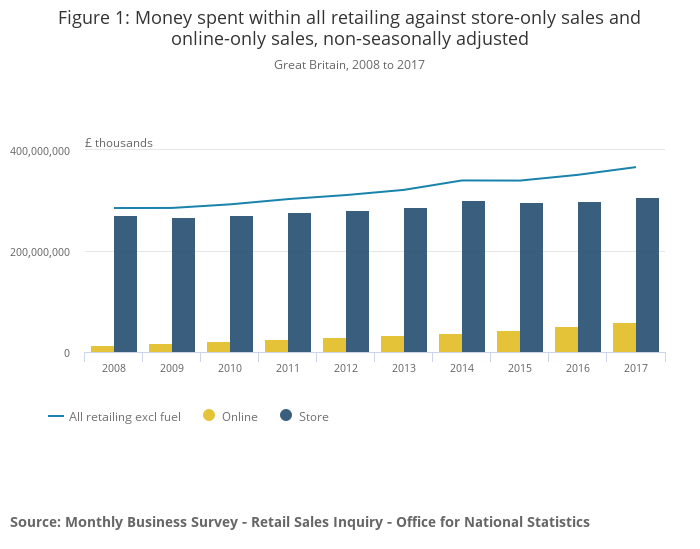
In fact, with the help of new technology, in particular, AI brick and mortar stores can take lessons from e-commerce and bring new innovations into the physical store. A study by Capgemini found that around 68% of pure-play online retailers have implemented artificial intelligence in some fashion, compared to only 10% of brick and mortar stores. Utilising new technology can often be the key to growth, so perhaps it’s no surprise that online retailing is growing at such a faster rate. This is beginning to change however, as physical stores are learning to adapt.
AI-assisted cross-selling in the store
The ability to cross-sell using AI is a huge strength of online retail. Online stores use machine learning to make intelligent and tailored product recommendations to customers while they are shopping This naturally increases sales, but does so relative to the quality of the product recommendations, hence the use of AI to perfect the process and make more successful recommendations. Brick and mortar stores have traditionally never been able to make use of cross-selling like this, having to rely on in-person customer service to drive sales. But as technology has improved, they can now make use of both.
The main reason for this is the emergence of chatbots as a mobile platform for in-store product recommendations. Whilst chatbots themselves originate from online, certain retailers now implement them in their stores to assist customers. Their primary function is often to assist customers if store associates are all occupied. Chatbots can help customers locate items, find more information on products and check stock availability, all through their smartphones. Intelligent AI-powered chatbots will then be able to recommend products similar to the item’s customers were searching for, not only increasing sales but improving the customer experience.
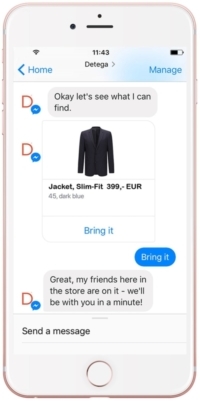
The fashion industry has taken this concept even further with the use of smart mirrors. Smart mirrors use advanced tagging technology (RFID) to sense the items that a customer brings into a fitting room. It will then display the products on the mirror and, like a chatbot, assist customers by providing information on other available sizes and colours and recommending products that are often bought with the ones being tried on. Most smart mirrors also have a feature that calls store staff to assist the customer, either providing face-to-face support or bringing the recommended items the customer has chosen to the fitting room. Smart fitting rooms are the epitome of the merger of the digital and physical in brick and mortar stores.
AI-powered in-store business intelligence
Artificial intelligence can also go a long way to revolutionising traditional brick and mortar store processes. One of the best examples of this is the use of AI assisted planograms. A planogram is essentially a plan of where items should be displayed on a shop floor to maximise customer purchases. In certain sectors such as fashion, planograms must be even more detailed and include the optimum display quantities of each different size and colour.
Artificial intelligence can revolutionise the planogram, using machine learning to constantly optimise not only the positioning of merchandise but the most efficient quantities of different articles to display on the shop floor. The advantages of this process being performed through AI are huge. Not only does it largely automate the process, saving time for staff, but it will constantly adapt and improve and can personalise and optimise the planogram on an individual store level.
The future of retail, online and in-store
To conclude, the impact of digital technology on the retail industry, in particular brick and mortar stores, has been significant but not actively catastrophic as many feared it would be. The emergence of ecommerce has gone from a threat to a strength for some physical stores. Not only has omnichannel retailing (something we did not have time to explore, but we go into detail on here) allied the different methods of shopping, but brick and mortar stores have now begun to incorporate certain technologies from online.
AI technology, originally something only online retailers could really utilise, is now finding its way into brick and mortar stores and improving both store processes and customer experience. We are also just scratching the surface of AI’s uses in retail and as more retailers choose to adopt the technology more benefits will be discovered. So, in reality brick and mortar stores are far from going extinct; they are in fact evolving and will continue to do so.
(Originally published on AI Business.com)
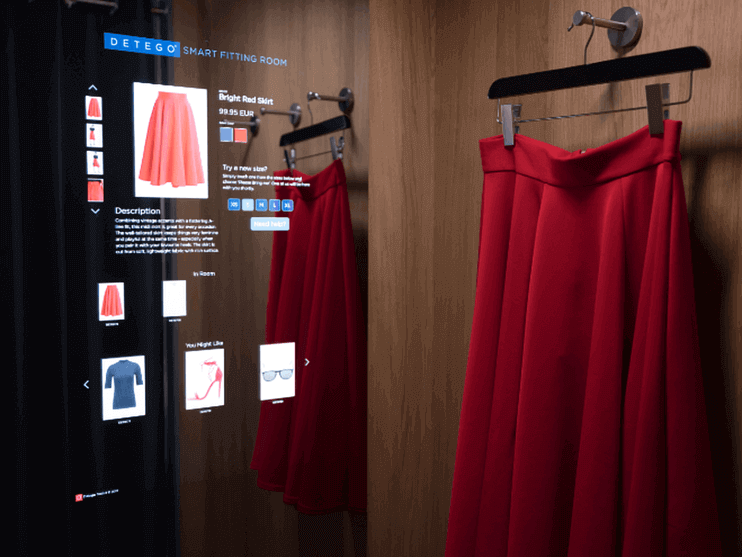
Did we spark your interest?
Planograms are a key part of running a retail store. In simple terms, they dictate the what, where and, the how many of products on the shop floor.
This article explores planograms, the challenges they present and how retails ongoing digital revolution along with artificial intelligence is changing planograms as we know them.
What is a planogram?
A planogram defines the location and quantity of products to be placed on display. They essentially function as blueprints for all merchandise within a store.
Alongside the visual merchandising element, planograms aim to optimise article availability and thus specifically stimulate sales.
So, a store planogram has two aspects:
1 – The Merchandising: which articles are presented on the sales floor and how (visual merchandising)
2 – The detailed quantities for individual colour and sizes (availability optimisation)
For example, a planogram might state where a formal shirt is displayed on the shop floor. The planogram will also state what quantities should be displayed, specific to different sizes and colours. So the planogram may state 3 mediums, 2 smalls, 2 larges and 1 extra-large are available on the shop floor, and so on.
Ideally, merchandising and planograms go hand in hand: customers are inspired by the presentation and then, their desired product is available in the matching size. The reality, however, often paints a different picture.
Planogram – Merchandising
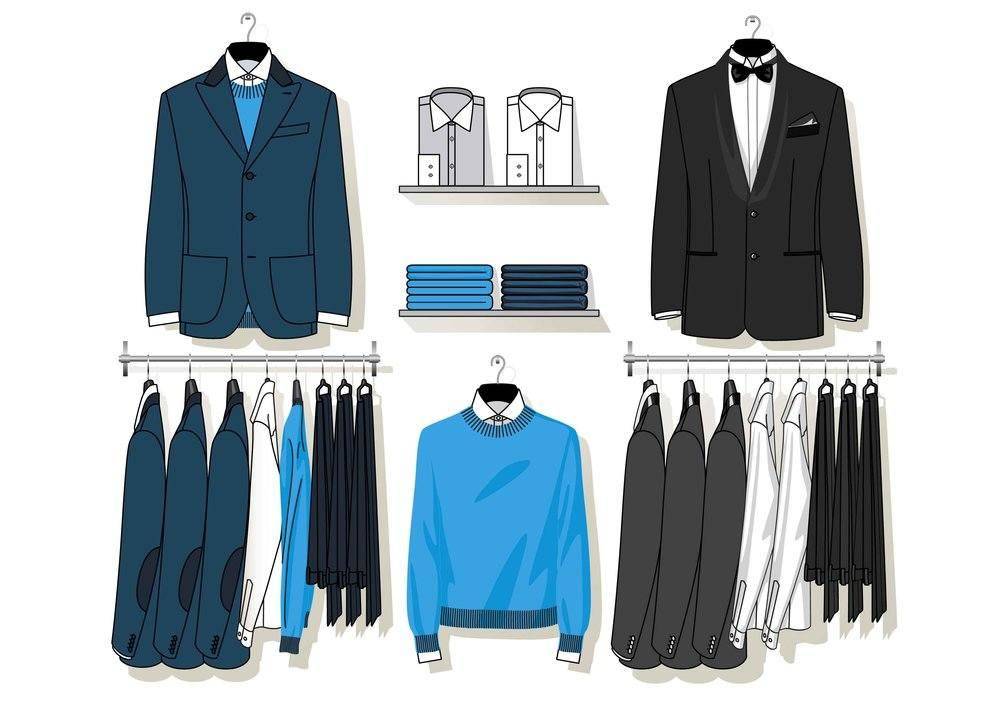
Planogram – Quantities and Priorities

Visually appealing and available in relevant sizes
What are the challenges of setting and maintaining a retail planogram?
Breaking this down, there are two questions that retailers face:
1) How do you define a planogram for my stores with a suitable size distribution?
The first question can be a challenge for retail depending on your definition of suitable. The reality is simply that manually creating and defining different size distributions for every single product is incredibly time-consuming and rarely worth the effort. This means generally stores will have a single set size distribution or ratio for every product in the store. This certainly could be worse, but it could (and can) be better….
2) How do you maintain the planogram on the shop floor? I.e. how to ensure that the products on the planogram are always on the shop floor
This, on the other hand, is a major challenge for retailers. What good is a planogram if it’s not adhered to? For example, if a planogram states that a size XL should be on the shop floor at all times but it is missing due to inaccurate or slow replenishment/refill, and a customer who needs that size can’t find it, more often than not that sale is lost.
There are two ways steps that go a long way to fixing this:
- Use a more specific and data-driven planogram in the first place (What we’re going to explore now)
- Having a better replenishment process in the store. (Like this one)
How does AI change the planogram?
Manual maintenance and adjustment of specific planograms is rarely a realistic option for retailers, especially when it comes to specific size distribution for individual products and stores.
By utilising artificial intelligence and machine learning procedures, it is possible to automate this process to define a precisely optimised size distribution for all articles across the store.
Not only does this save an enormous amount of planning time, but it also addresses the ongoing dynamics in individual stores. The self-learning system adapts to possibly changing conditions and continuously optimises the plan.
- Produces automated planograms based on sales data
- Produces optimised planograms for individual products
- Produces optimised planograms specific to the individual store
- Constantly adapts and optimised the planogram based on new data
AI planograms in action with the Detego platform
If this all sounds theoretical, its not.
During the operational process in the store, Detego InStore also supports the store personnel at several occasions: The software offers two parameters that provide information about article availability at any time and therefore represent important KPIs:
- On-floor availability: The percentage of all available articles that are currently displayed on the sales floor
- Planogram compliance: Provides information on how well the planogram with its individual size distribution is implemented on the sales floor
If one of the two parameters fall below certain threshold values, store staff needs to action: In addition to classic ERP systems, Detego InStore offers a finer level of granularity in the stores, by telling store staff that certain articles are available in the backroom but not on the salesfloor and therefore need to be refilled to comply with the predefined planogram.
Retailers benefit from a complete process for the planning and implementation. Another advantage: Refill advices in the app are sorted such that the search in the back room is made as efficient as possible by minimising walking routes.
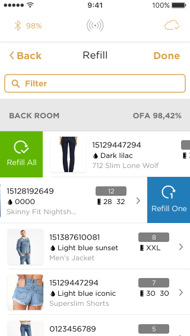
With AI planograms, shelf space is used for top sellers and is not wasted on sizes that are rarely or never bought. With its self-learning components, the Detego platform for the store makes a suitable proposal for all sizes and facilitates implementation in daily processes – including relevant KPIs for measuring performance. And if a certain size is not available in one store, the platform offers an exact inventory view of surrounding stores – ready for click & collect.
Benefits for retailers:
- Individually optimised AI planogram per store
- Efficient use of shelf space according to bestsellers per store
- Guided processes: from planning to refilling
- KPIs to provide insights on operational excellence per store – in real-time
Benefits for consumers:
- High on-floor availability for the locally popular sizes
- Positive customer journey
- Overall increased article availability through exact inventory data on the entire store network – including reservation options



